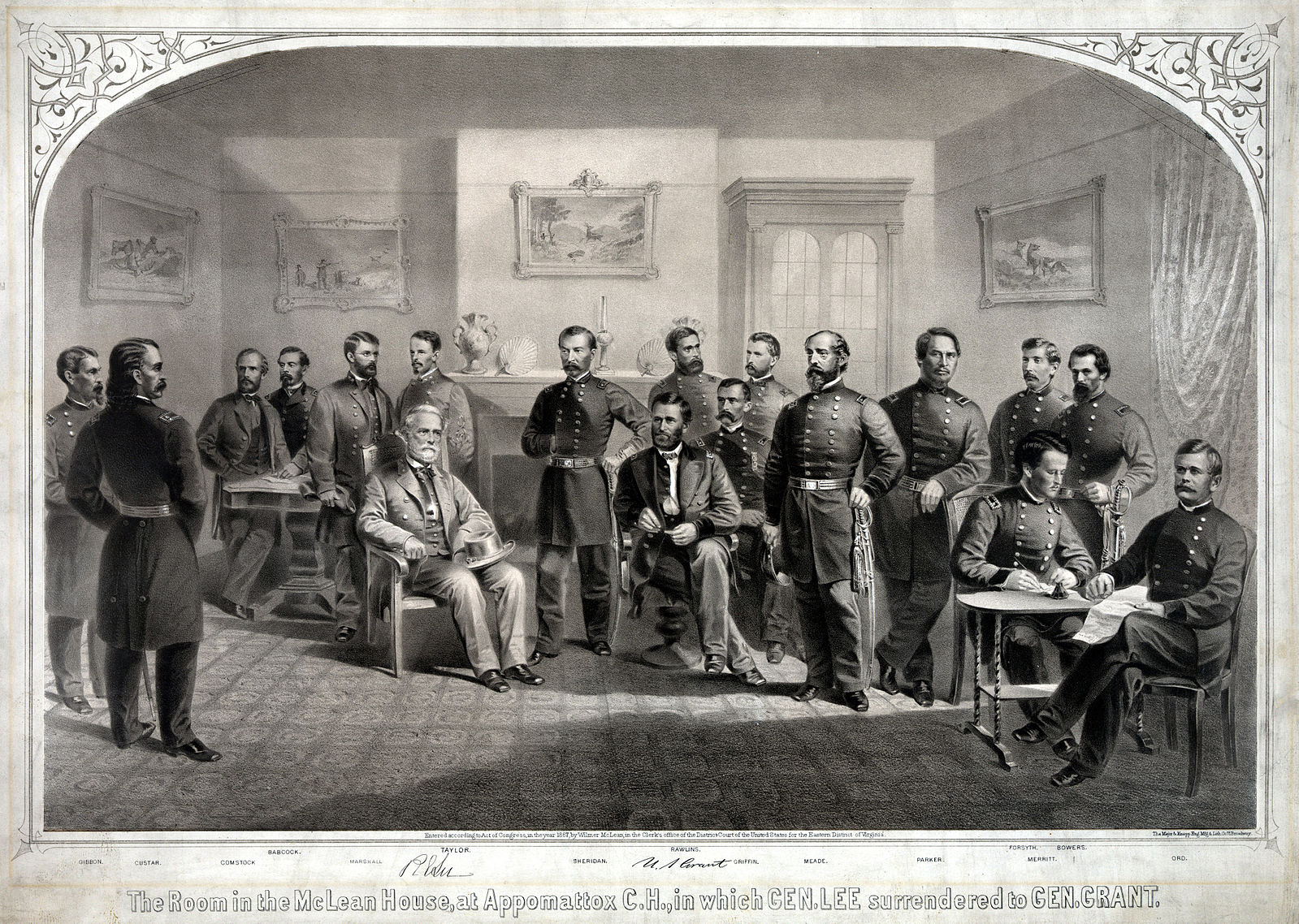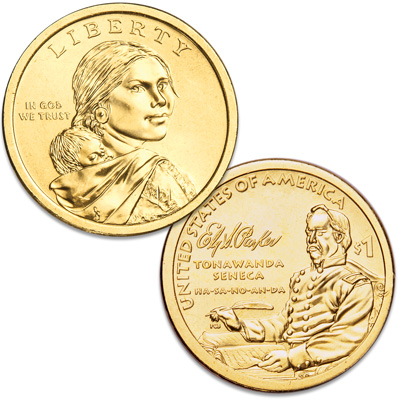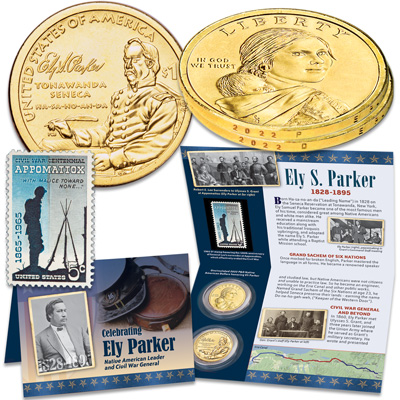2022 Native American Dollars Honor
the Life and Legacy of Ely S. Parker
Since 2000, the U.S. Mint has honored our nation’s Native American heritage and contributions on its coinage. First, on the Sacagawea dollars of 2000-2008. Then, in 2009, Sacagawea dollars were replaced by new Native American dollars that pair the Sacagawea obverse with changing one-year-only reverse designs.
As a series, Native American dollars have proven extremely popular. They offer a perfect blend of captivating designs and celebration of history. And that’s especially true with the new 2022 Native American dollars honoring Ely S. Parker (1828-1895).
Ely (pronounced “Ee-lee”) Samuel Parker was among the most famous men of his time, although today many Americans may not recognize his name. So let’s pull back the curtain of history, and get to know the man featured on the 2022 Native American dollar…
Ely Parker was always destined for greatness
Ely Parker was born in 1828 on the Seneca Reservation at Tonawanda, New York to – in his own words – “poor but honest Indian parents.” But while his parents may not have been wealthy, their lineage was distinguished. And it was clear from the start he was destined for greatness.
Four months before his birth, Parker’s mother – Elizabeth Johnson Parker – had a troubling dream. So she visited a Seneca dream interpreter to discover its meaning… and what she learned was startling:
A son will be born to you who will be distinguished among his nation as a peacemaker. He will become a white man as well as an Indian, with great learning; he will be a warrior for the palefaces. He will be a wise white man, but never desert his Indian people or ‘lay down his horns’ as a great Iroquois chief. His name will reach from the East to the West, the North to the South, as great among his Indian family and the palefaces. His sun will rise on Indian land and set on the white man’s land. Yet the land of his ancestors will fold him in death.
In light of the prophecy, Elizabeth named her son Ha-sa-no-an-da, which means “Leading Name.” And it proved a fitting name indeed. Because as fate would have it, virtually every word of the prophecy would come true.
He was a trained lawyer and a civil engineer
 Ely S. Parker, circa 1860-1865; photo by Mathew Brady
Ely S. Parker, circa 1860-1865; photo by Mathew BradyIn addition to a traditional Seneca upbringing, young Parker received a mainstream education at a local Baptist school. It was there he adopted the name by which he is best known today, choosing Ely after Baptist missionary Ely Stone.
Initially, his education did not go well and he struggled to learn English. But things changed when, at 13, he met a group of British soldiers who mocked him for his poor English skills. Parker vowed to master the language in all its forms, and did. Before long, he was renowned for his writing and speaking skills.
Parker initially sought a career in law, and worked at a legal firm for three years. However, he was unable to take the bar exam because he was not a U.S. citizen. So he switched his focus to engineering. And as a civil engineer, one of his first jobs was working on improvements to the Erie Canal.
As an Iroquois chief and diplomat, Ely Parker helped save the Seneca lands and way of life
Beginning at age 15, Parker was called upon by tribal elders to represent the Seneca in Washington as they fought to keep their land. And despite his youth, he impressed the Washington elites. At age 18, Ely Parker was invited to dine at the White House with President and Mrs. James K. Polk.
In 1851, the 23-year-old Ely Parker had impressed his tribal elders so much they named him Grand Sachem of the Six Nations. And along with his new title, he received a new tribal name: Do-ne-ho-ga-wa (“Keeper of the Western Door of the Iroquois Longhouse”).
As chief representative of the Iroquois confederacy, he continued to represent the Seneca in treaty negotiations with Washington. He saw mixed success, but he was able to preserve three-fifths of their lands and help maintain their way of life.
He was the first Native American general in the U.S. military
When the Civil War broke out in 1861, Parker offered to raise a volunteer regiment of Iroquois to fight for the Union. However, both the New York and federal governments flatly refused.
Determined to fight for the Union, Parker contacted a friend and former Army officer whom he had met a year earlier while working as an engineer in Galena, Illinois. His friend was none other than Ulysses S. Grant, who had rejoined the military and was now a general in the Union Army. Well aware of Parker’s abilities, Grant arranged for him to receive a commission.
Parker quickly proved he was as skilled an officer as he was an engineer, public speaker and diplomat. He served with distinction at Vicksburg, Mississippi. And by 1864, Colonel Parker was serving on General Grant’s staff as his military secretary.
 Ely S. Parker at Appomattox (back row, third from right); source: Library of Congress
Ely S. Parker at Appomattox (back row, third from right); source: Library of CongressEly Parker made many friends while serving on Grant’s staff, including President Abraham Lincoln and famed photographer Mathew Brady. And his service during the war proved historic indeed: he personally drafted and presented the articles of surrender for Confederate General Robert E. Lee to sign at Appomattox, Virginia.
Parker ultimately rose to the rank of brigadier general. After the war, he traveled frequently throughout the West to inspect and suggest improvements to military outposts. He also often met with Indian tribes to help resolve issues resulting from both the war and Washington’s policies.
The first Native American Commissioner of Indian Affairs
Ely Parker proved popular among the western tribes, and his experiences as emissary helped him envision a path to permanent peace between the United States and Native Americans. He submitted a four-point plan that was not only well received, but largely adopted as national policy.
Of course, it didn’t hurt that his long-time friend, Ulysses Grant, was elected President in 1868. And shortly after assuming office, President Grant appointed Parker Commissioner of Indian Affairs. He was the first Native American to hold the position, which caused quite a stir.
Parker promptly set out to purge the Bureau of Indian Affairs of the rampant corruption for which it had become known. However, in doing so he made numerous enemies. And they worked to undermine him, both in the bureau and Congress.
When Congress delayed funds desperately needed to provide promised food and supplies to reservations, Parker made his own arrangements. His actions likely prevented another Indian war, but gave his enemies the opening they sought.
A months-long Congressional investigation ensued. And while Parker was exonerated of all charges, a new law was passed that forced him to seek board approval on virtually any decision. Reduced to nothing but a figurehead, Parker resigned to seek a career outside of Washington.
Ely Samuel Parker died at his country house in Fairfield, Connecticut on August 30, 1895. He was buried in Fairfield with full military honors and much fanfare. But in 1897, he was returned to his Seneca tribal lands and reinterred with his ancestors – fulfilling the last parts of his mother’s prophetic dream.
Celebrating Ely S. Parker’s many achievements
on 2022 Native American dollars
Since 2009, the U.S. Mint has struck $1 coins celebrating the important contributions made by Native Americans to the history and development of the United States. So it’s only fitting that 2022 Native American dollars honor Ely S. Parker. Iroquois chief, diplomat, engineer and Civil War General, he was one of the most famous men of his day.
The coin’s reverse design depicts a seated Parker in military uniform. In recognition of his experience and reputation as an expert communicator, he is shown with a quill pen and a book. The design also includes a likeness of his graceful signature, above the inscriptions tonawanda seneca and ha-sa-no-an-da.
It’s a striking design. And you have several options should you choose to add it to your collection. Including 2022 “P” & “D” Uncirculated issues from the Philadelphia and Denver Mint issues and 2022-S San Francisco Mint Proofs.
And for a coin that really brings history to life, watch for Littleton’s exclusive colorized version in upcoming catalogs and at LittletonCoin.com!
What do you think of the 2022 Native American dollars featuring Ely S. Parker? Do you plan to add them to your collection? Let us know in the comments below!


 2022-P Native American Dollar
2022-P Native American Dollar

